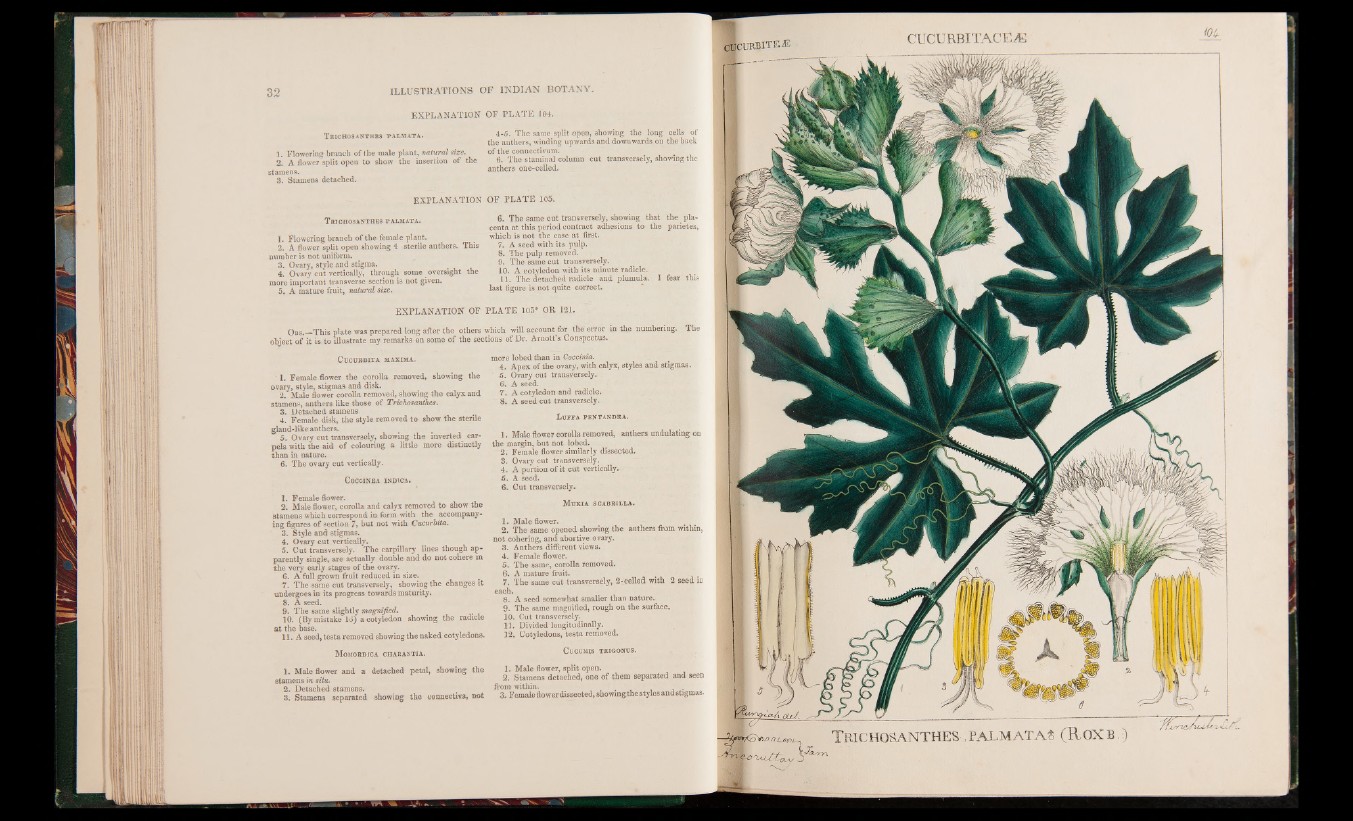
lilt ill
cIcUKBlTEÆ
1 ____ ____
EXPLANATION OF PLATE 104.
Trichosanthbs paxmata.
1. Flowering branch of the male plant, natural size.
2. A flower split open to show the insertion of the
4-5. The same split open, showing the long cells of
the anthers, winding upwards and downwards on^the back
of the connectivum.
6. The staminal column cut transversely, showing the
anthers one-celled.
EXPLANATION OF PLATE 105.
T richosanthes paxmata.
1. Flowering branch o f the female plant.
2. A flower split open showing 4 sterile anthers. This
number is not uniform.
3. Ovary, style and stigma.
4. Ovary cut vertically, through some oversight the
more important transverse section is not given.
5. A mature fruit, natural size.
6. The same cut transversely, showing that the placenta
at this period contract adhesions to the parietes,
which is not the case at first.
7. A seed with its pulp.
8. The pulp removed.
9. The same cut transversely.
10. A cotyledon with its minute radicle.
11. The detached radicle and plumula. I fear this
last figure is not quite correct.
EXPLANATION OF PLATE 105* OR 121.
Obs.__This plate was prepared long after the others which will account for the error in the numbering. The
object of it is to illustrate my remarks on some o f the sections of Dr. Arnott’s Conspectus.
CuCURBITA MAXIMA.
1. Female flower the corolla removed, showing the
ovary, style, stigmas and disk.
2. Male flower corolla removed, showingthe calyx and
stamens, anthers like those of Trichosanthes.
3. Detached stamens.
4. Female disk, the style removed to show the sterile
gland-like anthers.
5. Ovary cut transversely, showing the inverted carpels
with the aid of colouring a little more distinctly
than in nature.
6. The ovary cut vertically.
CoCCINEA XND1CA.
1. Female flower.
2. Male flower, corolla and calyx removed to show the
stamens which correspond in form with the accompanying
figures of section 7, but not with Cucurbita.
3. Style and stigmas.
4. Ovary cut vertically.
5. Cut transversely. The carpillary lines though apparently
single, are actually double and do not cohere in
the very early stages of the ovary.
6. A full grown fruit reduced in size.
7. The same cut transversely, showing the changes it
undergoes in its progress towards maturity.
8. A seed.
9. The same slightly magnified. _
10. (By mistake Id) a cotyledon showing the radicle
at the base.
11. A seed, testa removed showing the naked cotyledons.
Momordica charantia.
1. Male flower and a detached petal, showing the
stamens in situ.
2. Detached stamens.
3. Stamens separated showing the eonnectiva, not
more lobed than in Coccinia.
4. Apex o f the ovary, with calyx, styles and stigmas.
‘ 5. Ovary cut transversely.
6. A seed.
7. A cotyledon and radicle.
8. A seed cut transversely.
Luffa pentandra.
1. Male flower corolla removed, anthers undulating on
the margin, but not lobed.
2. Female flower similarly dissected.
3. Ovary cut transversely.
4. A portion o f it cut vertically.
5. A seed.
6. Cut transversely.
Mtjkia scabrilla.
1. Male flower.
2. The same opened showing the anthers from within,
not cohering, and abortive ovary.
3. Anthers different views.
4. Female flower.
5. The same, corolla removed.
6. A mature fruit.
7. The same cut transversely, 2-celled with 2 seed in
each.
8. A seed somewhat smaller than nature.
9. The same magnified, rough on the surface.
10. Cut transversely.
11. Divided longitudinally.
12. Cotyledons, testa removed.
CuCUMIS TRIG0NUS.
1. Male flower, split open.
2. Stamens detached, one o f them separated and seen
from within. .
3. Female flower dissected, showingthe styles andstigmas.
■
l i l l __j
W r
fm
' I I S
sot
m m
M u *
Trichosanthes , palmata* (R ox b ) V2